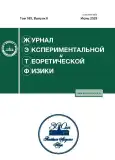Influence of the Encapsulating Layer Thickness on the Quality of MoSe2-Based Heterostructures
- 作者: Brichkin A.S1, Golyshkov G.M1, Chernenko A.V1
-
隶属关系:
- Osip’yan Institute of Solid-State Physics, Russian Academy of Sciences
- 期: 卷 163, 编号 6 (2023)
- 页面: 852-857
- 栏目: Articles
- URL: https://journals.rcsi.science/0044-4510/article/view/145423
- DOI: https://doi.org/10.31857/S0044451023060111
- EDN: https://elibrary.ru/DHDYOE
- ID: 145423
如何引用文章
全文:
详细
The dependence of the width of exciton and trion photoluminescence lines in MoSe2 monolayers on the thickness of hexagonal boron nitride encapsulating layers has been investigated. The possibility of variation of the exciton photoluminescence linewidth due to the interaction of excitons with the modes of resonator cavities made up of a silicon substrate and a boron nitride top layer has been checked. This interaction may significantly change the photoluminescence linewidth owing to the Parcell effect. Measurements taken of samples with different thicknesses of the bottom and top boron nitride layers have not revealed any influence of the Parcell effect on the linewidth. It has turned out however that the linewidth narrows by several times with increasing boron nitride bottom layer thickness from 10 to 100 nm and reaches 2 meV at a thickness of 100 nm. Supposedly, such narrowing of the photoluminescence line is associated with a decrease in the density of submicron bubbles, which takes place at longitudinal stress relaxation in the thicker layer of boron nitride.
作者简介
A. Brichkin
Osip’yan Institute of Solid-State Physics, Russian Academy of Sciences
Email: chernen@issp.ac.ru
142432, Chernogolovka, Moscow oblast, Russia
G. Golyshkov
Osip’yan Institute of Solid-State Physics, Russian Academy of Sciences
Email: chernen@issp.ac.ru
142432, Chernogolovka, Moscow oblast, Russia
A. Chernenko
Osip’yan Institute of Solid-State Physics, Russian Academy of Sciences
编辑信件的主要联系方式.
Email: chernen@issp.ac.ru
142432, Chernogolovka, Moscow oblast, Russia
参考
- G. Wang, A. Chernikov, M. Glazov et al., Rev. Mod. Phys. 90, 021001 (2018).
- Arash Rahimi-Iman, Semiconductor Photonics of Nanomaterials and Quantum Structures Applications in Optoelectronics and Quantum Technologies, Springer Series in Solid-State Sciences, Springer Science and Business Media Deutschland GmbH (2021).
- G. Moody, D. C. Kavir, K. Hao et al., Nat.Commun. 6, 8315 (2015).
- T. Jakubczyk, V. Delmonte, M. Koperski et al., Nano Lett. 16, 5333 (2016).
- F. Cadiz, E. Courtade, C. Robert et al., Phys. Rev. X 7, 021026 (2017).
- А. В. Черненко, А. С. Бричкин, Изв. РАН, сер. физ. 85, 245 (2021).
- J. Wierzbowski, J. Klein, F. Sigger et al., Sci. Rep. 7, 12383 (2017).
- H. H. Fang, B. Han, C. Robert et al., Phys. Rev. Lett. 123, 067401 (2019).
- G. D. Shepard, A. A. Obafunso, Li Xiangzhi et al., 2D Mater. 4, 021019 (2017).
- M. Selig, G. Berghaeuser, A. Raja et al., Nat.Commun. 7, 13279 (2016).
- J. C. G. Henriques, N. A. Mortensen, and N. M. R. Peres, Phys. Rev. B 103, 235402 (2021).
- T. Schmidt, K. Lischka, and W. Zulehne, Phys. Rev. B 45, 8989 (1992).
- S. Lippert, L. M. Schneider, D. Renaud et al., 2D Mater. 4, 025045 (2017).
- D. Kaplan, Y. Gong, K. Mills et al., 2D Mater. 3, 015005 (2016).
- E. Khestanova, F. Guinea, L. Fumagalli et al., Nat.Commun. 7, 12587 (2016).
- A. V. Tyurnina, D. A. Bandurin, E. Khestanova et al., ACS Photonics 6, 516 (2019).
- L. Schneider, S. Esdaille, D. Rhodes et al., Opt. Express 23, 37131 (2019).
- S. Du erwiel, S. Schwarz, F. Withers, et al., Nat.Commun. 6, 8579 (2015).
- T. LaMountain, J. Nelson, E. J. Lenferink et al., Nat.Commun. 12, 4530 (2021).
补充文件









